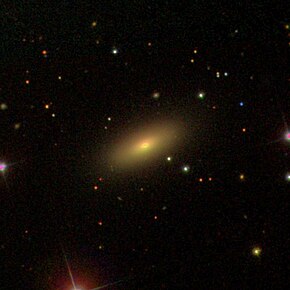| NGC 311 | |
|---|---|
 SDSS image of NGC 311 SDSS image of NGC 311 | |
| Observation data (J2000 epoch) | |
| Constellation | Pisces |
| Right ascension | 00 57 32.7291 |
| Declination | +30° 16′ 50.707″ |
| Redshift | 0.016489 |
| Heliocentric radial velocity | 4943 ± 14 km/s |
| Distance | 223.0 ± 15.7 Mly (68.37 ± 4.80 Mpc) |
| Apparent magnitude (V) | 14.00 |
| Characteristics | |
| Type | S0 |
| Size | ~128,000 ly (39.24 kpc) (estimated) |
| Apparent size (V) | 1.5' × 0.8' |
| Other designations | |
| 2MASX J00573274+3016508, UGC 592, MCG +05-03-028, PGC 3434, CGCG 501-049. | |
NGC 311 is a lenticular galaxy in the constellation Pisces. Its velocity with respect to the cosmic microwave background is 4636 ± 25 km/s, which corresponds to a Hubble distance of 223.0 ± 15.7 Mly (68.37 ± 4.80 Mpc). However, one non-redshift measurement gives a distance of 270 Mly (82 Mpc). It was discovered on September 18, 1828 by British astronomer John Herschel.
According to A.M. Garcia, NGC 311 is a member of the NGC 315 Group (also known as LGG 14). This group contains 42 galaxies, including NGC 226, NGC 243, NGC 262, NGC 266, NGC 315, NGC 338, IC 43, IC 66, AND IC 69, among others.
See also
References
- ^ "NASA/IPAC Extragalactic Database". Results for NGC 311. Retrieved September 2, 2016.
- "Distance Results for NGC 311". NASA/IPAC EXTRAGALACTIC DATABASE. NASA. Retrieved November 21, 2024.
- "New General Catalog Objects: NGC 300 - 349". Cseligman. Retrieved October 21, 2016.
- Garcia, A. M. (1993). "General study of group membership. II. Determination of nearby groups". Astronomy and Astrophysics Supplement Series. 100: 47. Bibcode:1993A&AS..100...47G.
External links
 Media related to NGC 311 at Wikimedia Commons
Media related to NGC 311 at Wikimedia Commons
| Astronomical catalogs | |
|---|---|
| NGC | |
This lenticular galaxy article is a stub. You can help Misplaced Pages by expanding it. |